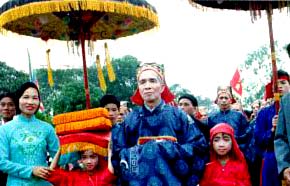Vietnam is one of the most linguistic diverse countries in Southeast Asia. Although Vietnamese is set as the official language of Vietnam, there are currently more than 100 speaking languages in the country. They belong to five different major linguistic families: Austronesian, Austroasiatic, Hmong–Mien, Sino–Tibetan, and Kra–Dai.
The Vietnamese language is an Austroasiatic language with monosyllabic and tonal features, sharing similarities with some Northern Austroasiatic languages, such as Bolyu. The writing of Vietnamese started with Vietnamese script (chữ Nôm) in the 13th century which used Chinese script as a basis, to the current Latin iteration (chữ Quốc Ngữ).
The current Vietnamese alphabet uses diacritics (glyph added to a letter) to represent tones in Vietnamese writing. When computerised, digraphs are used. For example, input ‘a’ generates ‘a’, but input ‘aa’ generates â.
The Vietnamese Latin alphabet uses the horn for the letters “ơ” and “ư”; the circumflex for the letters “â”, “ê”, and “ô”; the breve for the letter “ă”; and a bar through the letter “đ”.
It also has six tones: “á“, “à“, “ả“, “ã” and “ạ“, the five tones used for vowels along with flat tone “a“.
Music

A trio of Vietnamese musicians perform together. The man at centre plays a đàn nhị.
Vietnamese music varies slightly in the three regions: North, Central, and South. Northern classical music is Vietnam’s oldest and is traditionally more formal. Vietnamese classical music can be traced to the Mongol invasions, when the Vietnamese captured a Chinese opera troupe. Central classical music shows the influences of Champa culture with its melancholic melodies. Southern music exudes a lively laissez-faire attitude.
Vietnam has some 50 national music instruments, in which the set of percussion instruments is the most popular, diverse and long-lasting such as đàn đáy, đàn tranh, đàn nhị, đàn bầu … The set of blowing instruments is represented by flutes and pan-pipes, while the set of string instruments is specified by đàn bầu and đàn đáy.
Vietnamese folksongs are rich in forms and melodies of regions across the country, ranging from ngâm thơ (reciting poems), hát ru (lullaby), hò (chanty) to hát quan họ, trong quan, xoan, dum, ví giặm, ca Huế, bài chòi, ly. Apart from this, there are also other forms like hát xẩm, chầu văn, and ca trù.
Two of the most well-known Vietnamese traditional genres are:
- Imperial Court music: When referring specifically to the “Nhã nhạc” form it includes court music from the Trần dynasty on to the Nguyễn dynasty. It is an elaborate form of music which features an extensive array of musicians and dancers, dressed in extravagant costumes. It was an integral part of the rituals of the Imperial court.
- Ca trù: An ancient form of chamber music which originated in the imperial court. It gradually came to be associated with a pansori-type of entertainment where talented female musicians entertained rich and powerful men, often scholars and bureaucrats who most enjoyed the genre. It was condemned in the 20th century by the government, being tied falsely with prostitution, but recently it has seen a revival as appreciation for its cultural significance has grown. Ca trù has been recognized by UNESCO as a Masterpiece of the Oral and Intangible Heritage of Humanity since 2005.
In the 20th century, in contact with the Western culture, especially after national independence, many new categories of arts like plays, photography, cinemas, and modern art had taken shape and developed strongly, obtaining huge achievements with the contents reflecting the social and revolutionary realities. Up to 1997, there have been 44 people operating in cultural and artistic fields honored with the Hồ Chi Minh Award, 130 others conferred with People’s Artist Honor, and 1011 people awarded with the Excellent Artist Honor. At the start of 1997, there were 191 professional artistic organizations and 26 film studios (including central and local ones). There have been 28 movies, 49 scientific and documentary films receiving international motion picture awards in many countries.
Source: Wikipedia https://en.wikipedia.org/wiki/Culture_of_Vietnam







